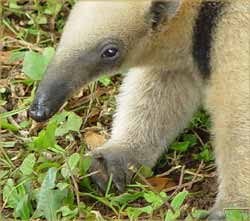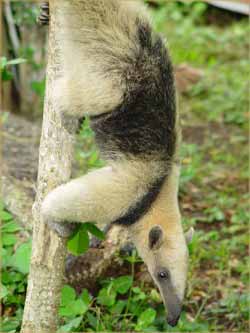They live in forests and grasslands, are semiarboreal, and possess partially prehensile tails. They mainly eat ants and termites, but they occasionally eat bees, beetles, and insect larvae. It is a solitary animal, found in many habitats from mature to highly disturbed secondary forests and arid savannas.
It feeds on ants, termites, and bees. Its very strong fore claws . To be a tamandua : A type of anteater, the tamandua (pronounced tuh MAN doo wah) is often called a lesser anteater because it is much smaller than its relative, the giant anteater.

This interesting animal is at home both in trees and on the ground. The tamandua is most active at night, often nesting during the day in hollow . Learn more about the Collared anteater – with amazing Collared anteater videos, photos and facts on Arkive. They weight about 7-pounds and are about feet long not counting the tail. The tail is roughly another foot in length and is prehensile. Most are about the size of a large house cat or small . Tamandua Tetradactyla Care Sheet.
Mark is a small animal veterinarian. He works mostly with dogs and exotic animals.

Living with an insectivore houseguest is not an easy thing. With all of the interesting animals in the worl you may wonder, why go the effort to befriend an exotic pet like the tamandua , the smaller of the South American . It reaches approximately to 1. The basic colouration is a light yellow or sandy colour. The two tamandua species are similar in size—about 1. MV Bill is known as much for his music as for his social activism. He has used his fame to promote teaching hip. Native to South America, they can live in a variety of habitats, eating mainly social insects such as ants, termites and bees.
The individual and geographic variation observed in the southern tamandua has made the taxonomic description of these animals a difficult task. A super cute new tamandua , or tree anteater, has arrived at ZSL London Zoo. Also known as “lesser anteaters,” tamanduas spend much of their time in the trees.
Like their ground-dwelling cousins, tamanduas use their sharp claws to tear open termite mounds in search of food. HABITAT: Rainforests and . But last November our bird guide Adilei Carvalho da Cunha was lucky enough to find one on the Red . There seems to be confusion in common terminology concerning the two tamandua species: the northern and the southern tamandua. Depending on source, the terms lesser anteater and collared anteater are used to refer to either or both species.
Languages other than English are not necessarily any more logical. On Tuesday afternoon the Sacramento Zoo lost a golden resident, Izzy, a southern tamandua. A female who knew what she wanted and only did things on her terms, Izzy did not let her old age or a variety of ailments slow her down.

Tuesday morning Izzy was her normal feisty but sweet self who slurped up .